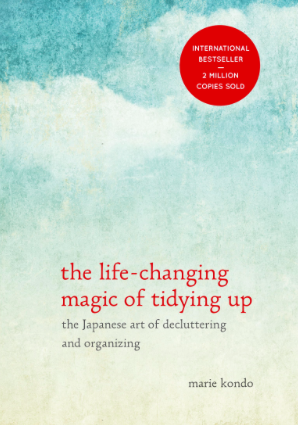Anxiety
The Life-Changing Magic of Tidying Up
Purging the house can clear the mind
Posted May 10, 2015

One of the advantages of being a psychiatrist as that we are allowed to be nosy about everything. Since I have a large clinical practice, I get asked for advice about all sorts of different subjects from ways to improve the sex life to medication side effects to medical problems to the best way to meditate. I’ve even had people ask me about getting septic systems pumped. My co-workers get many of the same questions, and we share a list of good resources about matters, whether psychiatric or not. Of course we do try to admit when we know nothing about a subject (the septic system was a stumper for me), but when it comes to life improvement, it’s good to have a working knowledge and some good books or websites to refer people to about many major areas, from how to start exercising, how to eat better, how to sleep better, and how to get along with loved ones. Good mental health involves so many aspects of one’s life, a psychiatrist or therapist has to be something of a generalist, soaking up wisdom in all different areas to be effective.
Recently a co-worker recommended a book about organizing, one she had pointed out to many of her patients with good success. Clutter and mess can feel incredibly overwhelming, and add to the stress of many patients. Often someone with a generalized anxiety disorder is the one with the least tolerance for clutter in the household, so they are the ones spending extra hours a day cleaning up for everyone. If there is some sort of easy way to keep a household clean and neat, that knowledge would help a lot of people, particularly those with OCD or anxiety.
Since I’ve often complained about the unmanageable clutter in my own life despite a distaste for buying too much and a regular habit of purging closets, old cosmetics, etc., I downloaded the book right away and started reading. Organizing is something I’d never studied, or even thought about studying, other than watching some of those reality TV shows where they empty out houses, have a yard sale, and clean up the place. I didn’t have a camera crew, an extra budget for organizing, or an accommodating family (kids are not amenable to decluttering, and my Yankee husband, having spent some time in his life going without, is loathe to part with anything we might be able to use: “Those old t-shirts would make good cleaning rags…”), so watching those shows never was much help to me personally.
Well, the book, The Life-Changing Magic of Tidying Up, by Marie Kondo, was similar yet surprisingly different from everything I’d ever seen before about decluttering and organizing. In the past when patients and friends asked me if I knew anything about organizing, I’d typically recommended something like the Flylady because it was common sense and matched with what many folks were telling me. They were overwhelmed by the prospect of decluttering a room, much less the whole house, so the Flylady suggests doing a “declutter shuffle” every day, removing 25 items, floating to different rooms of the house by day of the week. After a while, you have a nice, neat, happy and clean home.
Never mind that the Flylady advice never worked for me…but I had plenty of excuses. Flylady seems targeted to stay at home moms, for example. I always have to dress “to the shoes” and I’m never, ever going to clean the bathroom and sink every single day. Marie Kondo, however, tells us that methods like Flylady are ineffective and always lead to clutter rebound. In my own case, even with regular closet purges, I always ended up with stuffed closets and messy drawers…in other words, rebound, despite constant effort, and ever more difficult cleaning and organizing around all the clutter.
No, Marie Kondo tells us to purge first, all at once (or at least over a sustained period of a few months), and her method is different from nearly every other one I’ve heard of because instead of focusing on what you throw out, it tells you to focus on what you should keep. In essence, you are to keep only those things that you love, only possessions that give you a “spark of joy.” By building her method around that simple decision with the goal of having a house filled with only those things that bring you joy, all the sudden you are purging very large and meaningful amounts. In addition, it puts into place a whole new life philosophy about getting more stuff. Unless you *love* it, don’t bring it into the house. I’m hopeful the children will pick this up so they don’t fall into the trap of clutter, and that they appreciate having a few well-loved items rather than lots of whatever. I hope they spend their money (in general) on experience, not things.
It’s a paradox of modern life in the developed world that many of us have so much stuff it becomes a stressful burden while so many people in the world are going without. However, back in my student days (and when my husband was young), I often got good quality clothes I wouldn’t have been able to afford otherwise from Goodwill (my first job interview suit was Ann Taylor…I picked up it up secondhand for $12) while his family got their bikes and baseball bats and many other things they needed from the town dump. With websites like Freecycle you can declutter while giving others the clothes and stuff they may need.
I’ll list here Marie Kondo’s most significant rules, but I do encourage you to pick up the book (downloading means no additional physical clutter) or get it from the library, because her Eastern philosophy is critical to understanding why the rules work and why they make sense (and will seem a bit wacky to some Westerners). Her book also helps with the emotions around decluttering things like gifts people have given you, or important paperwork. Since her clientele are people in Tokyo with, presumably, much smaller accommodations and fewer possessions than we might have here in the US (she describes an average home as two stories and four rooms, and a very exceptional stockpile as 100 rolls of toilet paper). I wonder what she would think of my basement. Anyway, here are the rules:
1) Purge first, and purge everything in one go (or in a brief period of time). Keep only those items that give you a “spark of joy.”
2) Purge by category, not by room, starting with clothes, followed by books and then papers, misscelaney, and finally momentos. This method will show you all the duplicates you have hiding around the house and make the purge far more effective.
3) Do not invest in “smart storage solutions.” Complex storage is for hoarders. Get rid of the stuff rather than figuring out how to store it better.
4) That said, store things folded and standing up vertically, never stack. Stacking doesn’t work well in drawers (it wrinkles clothes and leaves the stuff on the bottom hard to get to) and stacking will make it easier to get more and more stuff, as things can be piled forever. This rule was a “headsmack” moment for me as it had never occured to me to fold clothes in drawers vertically so I could see all the items. If you don’t do anything else from her method, try it in your t-shirt, pants, or sock drawer. The results are amazing.

There is more to her method, and more to the book, but those are the basics. I haven’t followed her method exactly (I don’t follow recipes to the letter either, often resulting in disaster, but…), and yet my bedroom, closet, and the kids’ closets are as decluttered as they have been since I moved in to this house ten years ago. There’s a great deal of satisfaction and peace to be had from a decluttered space. I feel more in control of my life and less overwhelmed. I plan to recommend it to my patients and friends in the future…sorry Flylady!
Here’s a link to the book again.
Here’s Marie Kondo’s website: http://tidyingup.com
Here are some youtube videos showing people implementing the KonMari method:
My next post will be more sciency Evolutionary Psychiatry style…discussing the brain boosting benefits of chocolate.
Book image from tidyingup.com
copyright Emily Deans, MD




